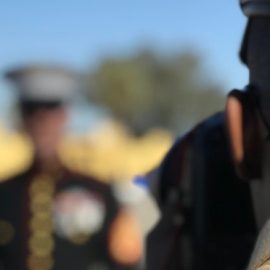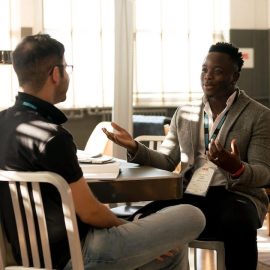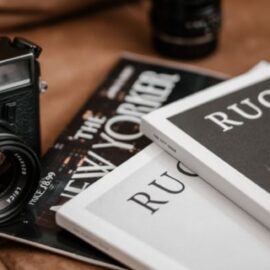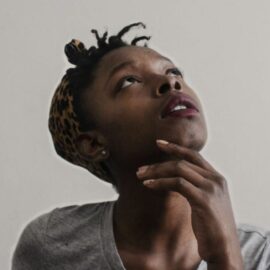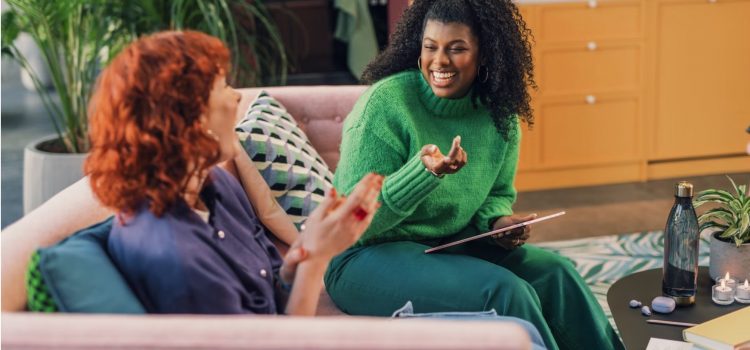
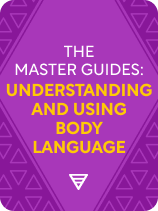
This article is an excerpt from the Shortform book guide to "The Master Guides: Understanding and Using Body Language" by Shortform. Shortform has the world's best summaries and analyses of books you should be reading.
Like this article? Sign up for a free trial here.
How can you use body language to make a better first impression? Do nonverbal cues play a big role in whether someone likes you?
You can make a better first impression by becoming more aware of your body language and intentionally signaling that you are friendly. Learning how and when to smile, make eye contact, and more can help you put your best foot forward.
Learn how to use body language to make a good first impression with new people with this guide.
How Body Language Influences First Impressions
In How to Talk to Anyone, Leil Lowndes argues that our body language—including our posture, how comfortable we appear, the way we smile, and the way we make eye contact—affects how others perceive us. Whether we’re conscious of it or not, our body language constantly emits signals about the way we feel. Because of body language, first impressions are often based more on how we come across in general than the specific words we use.
Others form instinctive impressions of us within the first few seconds of seeing us. Before we get a chance to utter our first words, they’ve already made assumptions about our personality, feelings, confidence level, and social or professional status. Most importantly, they’ve already decided whether we’re the type of person that they’d want to spend time with. You likely do the same with the people you meet.
Jack Schafer and Marvin Karlins explain how sending the wrong signals can impede your ability to make friends. In The Like Switch, they state that we often display “unfriendly” nonverbal cues—such as staring, frowning, or crossing our arms—without knowing it, even when we do want to establish personal connections. Learning what these unfriendly cues are can help you recognize if you’re unconsciously pushing people away, and avoiding them may make it easier to make friends.
Additionally, knowing unfriendly cues can help you spot when others aren’t interested in being friends with you. Learning what friendly body language cues look like helps you approach people who are receptive to meeting and getting to know you. (We’ll discuss specific friendly and unfriendly cues later in this guide.)
Crafting Body Language to Make a Better First Impression
Once you understand body language cues, you can begin to reliably interpret other people’s nonverbal communication. Likewise, you can craft effective body language to put forth the signals you want other people to see and make a good impression. This will help you to more easily form connections and make friends.
In this section, we’ll discuss cues that demonstrate openness, friendliness, and confidence.
What Does Friendly Body Language Look Like?
Friendly body language tends to be open and relaxed. These cues communicate interest, trust, and willingness to engage. If you’re approaching or trying to get to know someone, look for these cues to determine whether they’re open to it. Additionally, amend your body language so other people know you’re friendly, too.
Smiling
Schafer and Karlins state in The Like Switch that smiling is one of the most powerful ways to signal affection and openness. Furthermore, smiling people are seen as more attractive and more confident.
To get a warm response, you should look the recipient in the eyes, pause briefly, and then let out a big, warm smile while maintaining eye contact. The delay will convince recipients that you’re smiling just for them, and they’ll instantly feel like you’re happy to meet them.
Flashing Your Eyebrows
According to Schafer and Karlins, another cue that signals friendliness when greeting others is lifting your eyebrows and returning them to their resting position in a single, rapid movement. In The Like Switch, they argue that if someone doesn’t flash their eyebrows in greeting, we subconsciously perceive that person as someone to avoid.
Navarro (The Dictionary of Body Language) adds that we often flash our eyebrows when greeting friends and family. The movement happens in less than a second, signifying that we’re happy and excited to see the people we’re greeting.
Giving the Person Your Full Attention
In The Fine Art of Small Talk, motivational speaker Debra Fine recommends acting as if there are no distractions in the room when you’re conversing with someone. Face them openly and directly, and smile. Nod, make eye contact, and stay focused on the speaker. If you have trouble maintaining eye contact, Fine suggests you look at the space between their eyes instead of directly at them; they won’t be able to tell the difference.
Matching Body Language
In How to Talk to Anyone, Lowndes suggests imitating the other person’s gestures. This gives the impression that you’re similar in nature and instantly puts them at ease. For example, if they use their hands to make a point, use yours in the same way. Schafer and Karlins affirm in The Like Switch that when you have a strong connection with someone, you naturally match their body language during your interactions. For example, if a friend leans against a wall or takes a sip of their drink, you’ll repeat those actions unconsciously.

———End of Preview———
Like what you just read? Read the rest of the world's best book summary and analysis of Shortform's "The Master Guides: Understanding and Using Body Language" at Shortform.
Here's what you'll find in our full The Master Guides: Understanding and Using Body Language summary:
- How to better understand nonverbal communication
- How to use and interpret body language to form connections
- The body language you should avoid if you're looking to make friends

